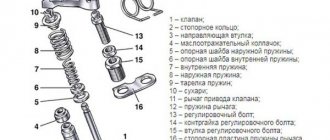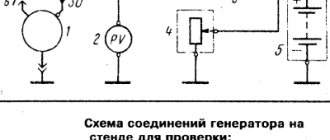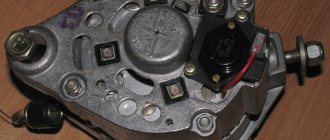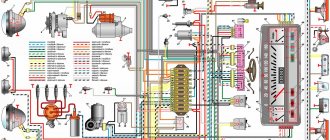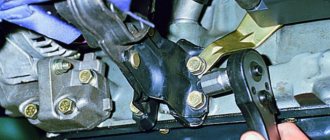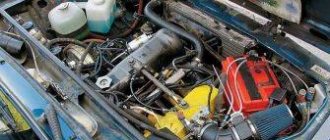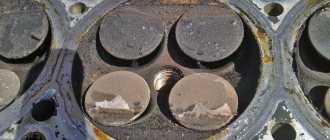Signs of an upcoming VAZ valve adjustment are a drop in engine power at high/low speeds and a characteristic metallic knock. , the seat and the valve itself will . And too large gaps provoke the same tapping.
Adjusting valves on a VAZ 2107 is considered a moderate task—novice auto repair workers should trust experienced mechanics.
The adjustment process itself on a VAZ 2107, be it a carburetor or an injector, occurs the same way. The differences lie in how to remove the cylinder head cover and set the pistons to top dead center - on injection-powered "sevens" you won't be able to get in with a ratchet.
In any case, to adjust the valves on the VAZ 2107 you will need :
- open-end wrenches for 13 and 17;
- probe 0.15 mm thick.
| The procedure for adjusting valves on a VAZ 2107 | ||
| TDC cylinder | Crankshaft rotation degree | Valves |
| 4 | 0 | 6 and 8 |
| 2 | 180 | 4 and 7 |
| 1 | 360 | 1 and 3 |
| 3 | 540 | 2 and 5 |
Why do you need valve adjustment?
In any automobile engine, the opening of the valves is necessary to fill the cylinders with the air-fuel mixture, and after they are hermetically sealed, combustion occurs in the chambers and the working cycle is completed. If you do not set the specifications, make them less than the required norm, or remove them altogether, there will be no tightness, and accordingly, the valves will not close completely, and the fuel mixture will not burn completely.
With increased clearances in the valve mechanism, a knock appears and intensive wear of parts occurs. Valve adjustment (VV) for each car model is carried out at the frequency specified in the technical specifications by the manufacturer; all service stations, car mechanics and car owners try to adhere to the recommendations.
Adjusting valves on a VAZ-2107 car (carburetor)
VAZ classic cars are equipped with engines of the same type, having almost the same design; they differ only in cylinder volumes (different diameters of pistons and liners, piston stroke). Also, the “Classic” can be equipped with a carburetor or fuel injection system, but the specifications are regulated in the same way. To adjust the gaps here you will need:
- open-end wrenches sizes 17 and 13;
- special wide probe 0.15 mm.
For the VAZ-2107, there is another RK method, which uses an adjustment rod and an indicator; a dipstick is no longer required here, or it can be used as a control tool.
The valves on the internal combustion engine are adjusted in a certain sequence; for this, marks are first placed on the crankshaft and camshaft, then the crankshaft is rotated 180º clockwise each time. Let's take a closer look at how to do this kind of work yourself, without missing any important points.
What you need to know in order to correctly measure the gap
Adjustment of the valve mechanism is carried out only after setting the cylinder pistons to the TDC position, with both valves (intake and exhaust) closed.
In this case, the rocker arms can move freely. To adjust, you need to use a wrench to loosen the lock nut of the adjusting screw, which is tightened after completing the adjustment procedure. Here you should be extremely careful, because as a result of improper tightening, the gap size may change up or down. Therefore, it is very important to tighten the lock nut correctly, and then re-check the gap size. Therefore, all cylinders must be checked
Rotate the crankshaft exclusively clockwise; for greater accuracy of its installation, be sure to use a special key or crank handle.
Do-it-yourself valve adjustment on the “Classic”
To adjust the valves on a rear-wheel drive VAZ car with a carburetor engine, prepare the tool and open the hood. The work should be done on a cold engine, the size of the feeler gauge for adjustment is 0.15 mm. We perform the following sequential actions:
- put the gearbox in neutral;
- unscrew the 3 nuts of the upper air filter cover (10th key);
- dismantle the cover and filter element;
- unscrew the 4 nuts securing the air filter housing (key 8), remove the crankcase gas hose, and move the housing to the side;
- disconnect the choke cable from the carburetor and the accelerator rod from the valve cover;
- unscrew the six bolts securing the cover;
- Having gained access to the valves, we proceed to adjustment. We take a 38mm wrench (special for a ratchet), place it on the crankshaft pulley nut, turn the crankshaft until the marks on the crankshaft align;
- We insert a feeler gauge between the r/v cam and the rocker (rocker arm), and measure the gap. The probe should enter with a slight force (tension), if it does not go through, or the gap is very large, it is necessary to make an adjustment;
- in this position of the marks, valves No. 8 and No. 6 are adjusted, the counting is carried out from the engine radiator;
- the excess clearance is determined by hand moving up/down with the feeler gauge installed; if the TK is higher than normal, the rocker will “play.” If the gap is less than the specified one, you will not be able to insert the feeler gauge;
- to adjust with a 17 key, loosen the lower lock nut, and by changing the position of the nut under the 13 key, set the required gap;
- Having adjusted the valve with the dipstick installed, holding it with the 13th key, tighten the locknut. There is one small nuance here: usually when the locking nut is tightened, the gap decreases somewhat (“tightens”), so when adjusting, the feeler gauge between the rocker and the camshaft should move a little more freely. However, you can easily adapt to this; everything becomes clear as you work;
- turn the crankshaft 180 degrees, the camshaft mark should move 90º, in this position we make the cam number 7 and 4;
- We turn the crankshaft again, here the upper mark will no longer be visible, so we are guided by the lower mark, which is located on the c/shaft pulley;
- in this position we adjust valves 1 and 3;
- Let's turn the crankshaft 180º again (the mark on the camshaft will be shifted 90 degrees from the top position, but in the other direction), adjust the clearances. No. 5 and No. 2.
Having completed the ROK, close the valve cover, start the engine, and check the operation of the engine.
How to adjust valve clearances on foreign cars
First of all, using the repair and maintenance instructions for your car, we determine the engine type. The fact is that some foreign cars can have up to ten types of engines on one car model. The tool required for adjusting and installing timing marks is also indicated there. However, in most cases a set of wrenches and feeler gauges is sufficient. Let's look at the features of adjusting clearances on a Mitsubishu ASX 1.6 with a gasoline and diesel engine.
Gas engine
This is what a Mitsubishu ASX 1.6 engine with a gasoline engine looks like.
To do this, follow these steps:
- Remove the plastic engine casing (held on by rubber latches).
- We remove the ignition coils and valve cover.
- We set both camshafts according to the marks (the nominal clearances of the intake and exhaust valves are also indicated here). We set the marks of the engine camshaft
- Using feeler gauges, we measure the gaps “Second and fourth cylinder - intake valves”, “First and third cylinder - exhaust valves”. We record the measurement results.
- Rotate the crankshaft 360 degrees. Then we align the marks on the camshafts and measure the clearances of other valves. We check the size of the engine valve clearances
- We remove both camshafts, take out the adjusting cups and use the given formula to calculate the size of the new cups. We adjust the valve clearances
- We install new cups and install the camshafts in the cylinder head.
- Apply sealant to the indicated places and tighten the valve cover. Apply sealant and tighten the engine valve cover
Valve adjustment table
Not everyone can remember by heart the order in which the valve should be made, so for those who are “forgetful”, special adjustment tables are compiled, from which you can easily understand at what position of the crankshaft a particular valve needs to be adjusted.
There are also tables of the dependence of the recommended gap on the ambient temperature; they can also indicate values for the RK using an indicator.
If you look at the table, you can understand from it that the optimal value of 0.15 mm is valid at an ambient temperature of +20ºC. If you decide to adjust the valves outside in winter at zero degrees, then in this case you need to set the gap to 0.135 mm, and if at +30º - 0.158 mm.
Preparatory work
Before starting the adjustment, you should perform the following operations:
- remove the air filter housing from the carburetor;
- remove the pipes and wires that prevent the dismantling of the timing cover;
- unscrew the nuts securing the timing cover;
- remove the timing cover.
Tip: for convenience, it is worth removing the distributor cover, this will make access to the valve mechanism easier. You also need to unscrew the spark plugs - without them there is no compression in the cylinders and it is much easier to turn the crankshaft.
When access to the valves is ensured, you can begin adjusting the thermal clearances. It should be remembered that the gap value of 0.15 mm was set by the designers for a cold engine. Therefore, before carrying out work, you must wait until the engine has cooled down. In addition, working on a hot engine can cause burns.
Adjusting the valves on a VAZ 2107 carburetor and on an injection model is absolutely no different. The only exceptions are engines on which hydraulic clearance compensators are installed. In this case, no adjustment is required.
Setting valve clearances using an indicator
The procedure for adjusting the indicator when using the indicator generally does not differ from the sequence of actions when adjusting using a probe, but a different tool is used. To adjust the valve mechanism in this case, you will need a rack (bar) and the indicator itself; the device is sold as a set in specialized auto stores. If you really want to, you can make a bar for installing the indicator yourself; finding the necessary drawing on the Internet is not a problem.
When setting the gaps using an indicator, a more precise setting is obtained, since the feeler gauge is not able to catch all the irregularities of the camshaft cams and wear on the rockers. The procedure for the RK using a special device is as follows:
- just as when adjusting with a feeler gauge, set the gear to neutral, open the hood, remove the valve cover;
- we combine the camshaft marks to adjust the 8th and 6th valves;
- We attach the indicator strip to the studs on the left side of the camshaft bed;
- if we adjust the sixth valve, we fix the indicator on top of the corresponding (6th) rocker using a holder;
- Using a key or hand, we raise and lower the rocker, and note on the indicator how many divisions the arrow deviates.
Here it makes sense to refer to the table, which provides data on indicator settings, since when adjusting with a probe, TK is measured in millimeters, and with an indicator - in divisions. For example, for a standard value of 0.15 mm the indicator value is 52, which means that the arrow with the required gap deviates by fifty-two divisions. If the TK is greater than the norm, it needs to be reduced; let’s look at how this happens:
- Let’s say, instead of the required 52, the indicator showed the value 72 (“extra” 20 divisions);
- set the arrow to “zero”, loosen the lock nut, use a 13mm wrench to turn the adjusting bolt towards decreasing the gap, watch the indicator;
- when you turn the key, the indicator needle begins to deviate counterclockwise, it is necessary that it “passes” 20 divisions (since 72-52 = 20);
- Having achieved the desired reading on the dial gauge, holding it with a key of 13, use the “seventeenth” key to tighten the lock nut;
- Having adjusted both valves (8 and 6) in this way, turn the shaft and adjust the cl. No. 4 and 7, then we then repeat all the operations that were described earlier for a carburetor internal combustion engine.
After the adjustment, install the valve cover, start the engine, see how it works, listen for any extraneous sounds.
Signs and consequences of improper clearance
Ideally, the precision of the valves ensures zero clearance. Then the valve will clearly follow the trajectory specified by the camshaft cam profile. It has a rather complex shape that is carefully selected by the motor developers.
But this can only be realized with the use of hydraulic gap compensators, which, depending on the specific design, are also called hydraulic pushers and hydraulic supports.
In other cases, the gap will be small, but quite finite, depending on temperature. ICE developers experimentally and by calculation determine what it should be like initially, so that in any conditions, changing the gaps does not affect the operation of the engine, causing damage to it or reducing its consumer qualities.
Big gap
At first glance, increasing valve clearances looks safe. No thermal changes will reduce them to zero, which is fraught with problems.
But the growth of such reserves does not pass without a trace:
- the engine begins to make a characteristic knock, which is associated with increased acceleration of parts before coming into contact;
- shock loads lead to increased wear and chipping of metal surfaces, the resulting dust and chips disperse throughout the engine, damaging all parts that are lubricated from a common crankcase;
- The valve timing begins to lag due to the time required to select the gaps, which leads to deterioration in performance at high speeds.
It is interesting that a loudly knocking engine with huge gaps can pull perfectly at low speeds, acquiring, as they say, “tractor traction.” But you cannot do this deliberately; the motor will quickly be worn out by products from surfaces subject to shock loads.
Small gap
Reducing the gap is fraught with much faster and irreparable consequences. As it warms up, the insufficient clearance will quickly become zero, and interference will appear in the joint of the cams and valves. As a result, the valve discs will no longer fit tightly into their seats.
The cooling of the valve plates will be disrupted; according to calculations, they dump some of the heat into the metal of the head during the closing phase. Even though the valves are made from heat-resistant steels, they will quickly overheat and burn out using the high temperature and available oxygen. The motor will lose compression and fail.
Valve mechanism malfunctions
A situation often arises when, even after adjustment, the valves continue to knock, and the knocking can be quite strong and unpleasant. The main reasons for extraneous noise in this case:
- worn camshaft cams;
- development on rockers;
- camshaft play in the bed (aluminum body);
- wear of pushers.
To determine the defective parts, it is necessary to remove the r/shaft and do a visual inspection. The wear of the camshaft bearings is determined using a micrometer; each of the bearing journals has its own specific size.
Adjustment of valve clearances on rear-wheel drive VAZ cars is usually carried out every 20-25 thousand kilometers, also when knocking occurs or there is a suspicion that the valves are “pinched”. If the gaps are less than normal, the engine runs unevenly, especially at idle, acceleration dynamics are lost, and dips appear.
You need to pay attention to the operation of the valves in the car if a characteristic knocking sound occurs during engine operation, with a noticeable drop in its power, an increase in fuel consumption, and also with unstable idling. Due to some design features of the car's gas distribution system, it needs servicing approximately every six months. For many motorists, adjusting the VAZ 2106 valves with their own hands has become a familiar procedure, even because this work is not particularly difficult.
Adjustment features for an injection engine
The VAZ-2109 valve adjustment described above (carburetor) is also suitable for an injection engine. The only difference lies in the preparatory process. When preparing for work, several other actions are required, namely:
- remove the throttle cable;
- remove the breather hose.
Now you know how to correctly adjust the VAZ-2109 valves. An injector or carburetor powers the engine - this does not play a significant role, because the design of the engine itself remains the same.
The procedure for measuring the gap and adjusting it is very simple and requires the owner to perform it in the correct order. The entire procedure can take no more than 30 minutes.
Why do you need valve adjustment?
If you carefully examine the valve system of the “six”, its design can be roughly compared to a rocker arm diagram. Rotating, the camshaft presses its cam on one side of the rocker arm, lifts it, while the second edge, located on the top of the valve, lowers the rocker arm, thereby opening paths for injection of the fuel mixture or for removing gases.
It is necessary to provide a certain gap between the parts in question. The valve opens to an extent that ensures the correct functioning of the motor.
If the gap is too small, the valves do not close completely, which causes a decrease in engine power, entails excessive fuel consumption and failure of the valves themselves. In addition, due to the discrepancy between the clearances and the standard indicators, engine noise increases, the rods are deformed, and accordingly, the under-closing gap of the valve itself increases even more.
The procedure for adjusting the valves of the VAZ 2106
1. At the very beginning, the gas distribution mechanism is disassembled - these actions will open access to setting up and adjusting the parts. For this purpose, the air filter is removed.
2. The next step is to remove the valve covers, which will allow you to see the camshaft housing and other internal parts.
3. The crankshaft is rotated so that the marks on the pulley and the front oil seal cover match. When the shaft is in this position, the compression stroke begins in the fourth cylinder.
4. The gap is checked: for this, a 0.15 mm feeler gauge is used, the insertion of which must be accompanied by a certain force. Gap adjustment is required if the feeler gauge passes into the gap too easily, or if it does not pass at all.
5. Use a wrench “14” to hold the adjusting bolt, and use a wrench “17” to loosen the lock nut. By turning the bolt, the required clearance is established, the bolt is secured with a lock nut. After performing these steps, a control measurement is carried out with a probe.
To adjust the valves as correctly as possible, you need to follow a certain procedure:
- Valves No. 6 and No. 8 are adjusted, the crankshaft is turned half a turn;
- A similar operation is carried out with valves No. 4 and No. 7, rotate the shaft;
- Valves No. 1 and No. 3, shaft rotation;
- Finally, the clearance of valves No. 5 and No. 2 is set.
After these steps, several full turns of the shaft are performed, a control check of the gaps is made with a feeler gauge, and all previously removed parts are assembled.
In fact, we were able to verify that adjustment with a feeler gauge is not particularly difficult; in fact, the shaft is turned and the bolts are adjusted. But this method is frankly inaccurate due to the existing wear at the points of contact between the cam and the rocker arm.
The above disadvantage does not exist if the gap adjustment is carried out using an indicator and an adjusting rod.
Puller drawings. Repair equipment. Tool
Device for tensioning the timing belt (for a new type of roller).
The device is a metal, slightly curved strip, 2 - 3 mm thick, 120 mm long. and width - 25 mm. On one side at a distance of 10 mm. two pins with a diameter of 4 mm are installed from the end. The height of the pins is 10 mm, the distance between the pins is 17 mm. The diameter of the semicircle is 16 mm. Everything should be clear from the photograph of the device.
Instead of this device, to tension the timing belt, you can use two drills (4 mm in diameter) inserted into the holes of the tension roller. We insert a screwdriver between the drills and use it as a lever to tighten the timing belt.
Device for adjusting valves.
Due to the relative complexity of this device and its low cost (less than 200 rubles), I recommend just buying it.
As a last resort, you can use a pair of regular flathead screwdrivers. Using one powerful screwdriver, we recess the pusher, and with the second (you can bend it a little and sharpen it in place) we fix the pusher by the side. But this method is extremely inconvenient and the fixing screwdriver can fly out; in general, it’s only suitable as a last resort.
Adjusting valve clearances using an adjusting rack
1. As in the case described above, the car must be placed on a level surface. This second adjustment method will allow you to achieve greater accuracy when performing work. The same tools are used and the same steps are followed to remove the filter.
2. After aligning the marks of the pulley and the oil seal cover, install the rack, which is attached to the camshaft housing with three bolts.
3. Next, a dial indicator is installed in the slot on the rail, its scale is set to zero.
4. The existing gap is measured and, if necessary, adjusted in a similar way to the feeler gauge adjustment method. The adjustment is carried out according to the scheme discussed in the first case.
As a result, properly adjusted valves will reduce fuel consumption, increase engine power, stabilize its operation and reduce noise generation.
Below you can watch a video on how to independently adjust the valves on a VAZ-2106.
The need to adjust the valves in VAZ-2106 cars arises as the gas distribution mechanism consumes a certain resource. Constant exposure to high temperatures leads to the loss of its elements of their original properties. As a result, the gaps between the camshaft cams and the pressure levers increase.
Wear problems
The displacement of valves from their seats entails several negative factors:
- Increased fuel consumption due to unstable operation and interaction of pistons and valves. In the process of shifting the location of the valve, it does not perform its function so accurately; the overall efficiency decreases, causing mechanical losses in operation, which in turn leads to an increase in the car’s fuel appetite;
- Increased natural wear of engine parts. Parts made of steel are subject to constant impact and wear out over time. However, wear processes can be stimulated by inaccuracy in the placement of parts, and valves serve as a striking example. As the required clearances increase, wear increases and, accordingly, the overall engine life is reduced.
Therefore, engine valves require periodic adjustment in order to maintain the wear resistance of the entire vehicle system. In modern engines equipped with hydraulic compensators, the valve adjustment procedure is not required; the 402 engine does not belong to this series and requires periodic adjustment.
On video how to adjust valves on a 402 engine:
When is it necessary to adjust valves?
The normal gaps between the cams and levers provided for by the design of the VAZ-2106 engine are 0.15 mm, and reducing or increasing them will entail a number of consequences. Although their non-compliance with the established requirements does not pose an emergency hazard to the entire engine, it causes rapid wear of parts, engine overheating, a decrease in its power, and increased fuel consumption.
Typically, valve thermal clearances are adjusted every 20-30,000 km, as well as after any repair work related to the gas distribution mechanism. In addition, such a need may arise due to malfunction of other engine systems or mechanisms.
The main sign that it is time to adjust the valves is a characteristic knocking sound coming from under the valve cover. It can also be clearly heard from inside the car when the hood is closed. It is important here not to confuse this sound with the clatter of piston pins, which can occur during detonation. Valves, unlike fingers, “knock” both at idle and under load. The latter, in the event of detonation, reveal themselves only under load.
Main malfunctions of the VAZ 2101 timing belt
According to statistics, every fifth engine malfunction occurs in the gas distribution mechanism. Sometimes different faults have similar symptoms, so a lot of time is spent on diagnosis and repair. The following are the most common causes of timing belt failure.
- Incorrectly set thermal gap between rockers (levers, rocker arms) and camshaft cams. This results in incomplete opening or closing of the valves. During operation, the valve mechanism heats up, the metal expands, and the valve stems elongate. If the thermal gap is set incorrectly, the engine will have difficulty starting and will begin to lose power, popping noises will appear from the muffler and a knocking noise will appear in the engine area. This malfunction is eliminated by adjusting the gap or replacing the valves and camshaft if they are worn.
- Worn valve stem seals, valve stems or guide bushings. The consequence of this will be an increase in engine oil consumption and the appearance of smoke from the exhaust pipe during idling or acceleration. The malfunction is eliminated by replacing the caps, valves and repairing the cylinder head.
- Failure of the camshaft drive as a result of a weakened or broken chain, breakdown of the tensioner or chain guide, wear of the sprockets. As a result, the valve timing will be disrupted, the valves will freeze, and the engine will stall. It will require a major overhaul with the replacement of all failed parts.
Valve valves may become bent as a result of slipping or broken timing chain. - Broken or tired valve springs. The valves will not close completely and will begin to knock, and the valve timing will be disrupted. In this case, the springs should be replaced.
- Incomplete closure of valves due to burning of the working chamfers of the valve plates, the formation of deposits from low-quality engine oil and fuel. The consequences will be similar to those described in point 1 - repair and replacement of the valves will be required.
- Wear of bearings and camshaft cams. As a result, the valve timing will be disrupted, the power and throttle response of the engine will decrease, a knock will appear in the timing belt, and it will become impossible to adjust the thermal clearance of the valves. The problem is solved by replacing worn elements.
After eliminating any of the malfunctions of the VAZ 2101 engine, it will be necessary to adjust the gap between the rockers and the camshaft cams.
Video: the influence of thermal valve clearance on timing belt operation
Preparation stage
Adjusting the valves of the VAZ-2106 is not particularly difficult and does not require the use of special tools. Here you will need:
- a set of wrenches (heads) for 10, 13 and 17;
- key (head) 36 for cranking the crankshaft;
- Screwdriver Set;
- a measuring probe with a thickness of 0.15 mm (included in the tool kit for the car from the factory, can be purchased at any auto store or a special strip with an indicator);
- new valve cover gasket;
- automotive sealant;
- assistant (for greater convenience when setting valve timing).
The car must be placed in a viewing hole, secured with the parking brake, and the engine must be allowed to cool completely. After this, open the hood and remove the air filter: it will interfere with the removal of the valve cover.
Instructions
Before starting work, allow the engine to cool completely. Check the timing marks and chain tension - correct if they do not meet the standards. The instructions will describe the method of adjustment using a micrometer.
Carburetor pan VAZ 2106
Adjustment using the old-fashioned method (with a feeler gauge) is performed in the same sequence, with the exception of the point about measuring gaps.
- Remove the carburetor pan and remove the hose from it.
- Disconnect the accelerator pedal drive.
- Remove the valve cover of the Six power unit.
- Remove the ignition distributor cover.
- Turn the engine by the flywheel. Turning is done with a special key. Removing the spark plugs will make the turning procedure easier. As a result of turning the power unit, the marks on the camshaft sprocket should align with the mark on the bearing housing. For complete reliability, you can check the coincidence of the marks on the crankshaft pulley and the engine.
- Mark the marks on the camshaft sprocket with a marker. Marks are applied on top of the factory ones every 90 degrees.
- Screw the rack onto the camshaft bed mounting. It must be securely fixed.
- Place the indicator on the rack.
- Place the indicator on the edge of the adjustable valve cam.
- Engage the cam using the special grip and pull up. There should be a change in indicators by 52 divisions.
- If there is a deviation in the indicator, the gap needs to be adjusted. Using a size 17 wrench, you need to unscrew the lock nut 1-2 turns and use a size 13 wrench to adjust the gap. After this, carry out another check of the adjustment with a micrometer. If everything is correct, tighten the locknut. After this, you need to re-check the gap - the gap may have decreased after tightening the locknut. When adjusting the gap, you need to leave a margin.
All engine valves are adjusted in this way. To get to the valves you need to crank the engine. There is a clear procedure for adjusting the valves. It is indicated in the adjustment table.
Gap table for correct engine valve adjustment.
At the end of the procedure, it is advisable to crank the engine and check the clearances again. The structure is assembled in the reverse order. Be sure to replace the disposable valve cover gasket.
We repair a VAZ 2106 car ourselves:
- Adjusting the ignition of a VAZ 2106 on your own
- Tuning VAZ 2106 on your own
- Do-it-yourself VAZ 2106 starter repair
Adjustment using a feeler gauge
1.Using a 10mm wrench (socket), unscrew the eight bolts securing the valve covers. Disconnect the crankcase ventilation hoses from it. Carefully remove it and set it aside.
2. Before proceeding with the adjustment, you need to check the tension of the timing chain. If she's okay, we move on.
3. Set the piston of the fourth cylinder to the position of its top dead center. To do this, you will need to turn off the gear, go down into the pit, remove the engine mudguard, then use a “36” wrench or a similar head placed on the crankshaft pulley mounting nut to turn it until the marks on the camshaft sprocket and its bearing housing coincide . The same procedure can be carried out by jacking up and turning one of the rear wheels with 4th gear engaged, or by slowly pushing the car (if there is no inspection hole).
4. When the marks coincide, valves 6 and 8 (counted from the front of the engine from left to right) should be completely closed, and their clearances between the cams and levers should be maximum.
5.Insert the dipstick into gap 6 of the valve. It should enter there with noticeable resistance. If the gap is greater than the thickness of the feeler gauge, or the feeler gauge cannot be pushed into the gap, adjustment is required.
6.To do this, take a 17mm wrench, place it on the locknut, and use another 13mm wrench to loosen or tighten the adjusting screw, achieving the desired amount of clearance. It should be noted here that as the locknut is tightened, it may change the gap, so measurements will need to be repeated after tightening it.
7.In the same way we adjust the gap on the 8th valve.
8.After this, it is necessary to turn the crankshaft exactly 180 0 in the manner described above, and adjust the 4th and 7th valves.
9. Next, rotate the crankshaft 360 0 and adjust the clearances of valves 1 and 3.
10.The next stage is to turn the crankshaft by 540 0 with adjustment of 5 and 2 valves.
Below is a table indicating the crankshaft rotation angle and the procedure for adjusting the thermal valve clearances.
| Crank angle | 0 0 | 180 0 | 360 0 | 540 0 |
| Camshaft angle | 0 0 | 90 0 | 180 0 | 270 0 |
| Cylinder number | 4,3 | 2,4 | 1,2 | 3,1 |
| Adjustable valve number | 6,8 | 4,7 | 1,3 | 5,2 |
Interaction of gas distribution mechanism parts
The camshaft, rotating, presses the cams onto the adjusting washers, which are located in the pushers mounted on the ends of the valve stem. Thereby pushing the parts whose caps are located in the valve seats. The seats and caps are very precisely ground to each other, this is done so that at the moment when the cap of the part is completely seated, a hermetically sealed connection is formed into the saddle. The channel is completely blocked.
This is why the engine runs stably and produces the required power, saving fuel. As the engine operates, the working surface of the cams wears out, they lose their dimensions, and the gaps increase.
Because of this, the caps do not fully adhere to their saddles, as a result of which the tightness of the saddle-cap connection is lost. In order to restore this tightness, adjustment of the VAZ valve clearances is required. For this purpose, adjusting washers are used. These washers themselves are round in shape and the circumference diameter is the same as that of the pusher (pos. A in the figure above). The photo below shows some examples of these round washers:
Here are eight washers of different thicknesses. The thickness is written on the washer itself in millimeters. Valve clearances are adjusted by selecting washers of the required thickness. Sometimes you have to change these washers several times, each time inserting a washer of a different thickness, until the valve clearance reaches the desired size.
They are usually sold in sets starting from a thickness of 3mm, the next size is 3.05mm. And so on every 0.05mm, up to a size of 5mm.
Adjustment features and dimensions
The main condition in this matter is that the engine must be cold. Those. its temperature should be no more than 20 degrees Celsius.
We will carry out further actions by looking at the figure below. For ease of operation, it is better to unscrew the spark plugs! This will make it easier to operate all the mechanisms and shafts involved in this process, since there will be no compression. Turn the crankshaft so that the mark on the camshaft pulley coincides with the mark on the rear cover of the gear shaft (tendril).
We must immediately examine the remaining marks in the crankshaft area. They should be located exactly as shown in the figure. This means that the piston of the first cylinder is in the TDC position. Next, you need to turn the crankshaft by about forty to fifty degrees, this is necessary so that the camshaft cams turn from the pushers.
Using feeler gauges, you need to measure the gaps of the 1st, 2nd, 3rd and 5th valves. The gaps on the 2nd and 3rd valves should be (0.2+-0.05mm.). On the 1st and 5th valves the gap should be (0.35+-0.05mm). If some gaps do not correspond to the standard, then they are brought to the required dimensions by replacing the adjusting washers, selecting them until the goal is achieved.
After this, you need to rotate the crankshaft 360 degrees, i.e. one full turn and check the clearances on the 4th, 6th, 7th and 8th valves. On the 4th and 8th cylinders the gap should be (0.35+-0.05mm). On the 6th and 7th cylinders, the clearance should be (0.2+-0.05mm). Well, accordingly, if there are incorrect gaps, we correct them in the same way as the first time.
Adjusting valves using a gauge indicator (rack)
Most car owners adjust the valves using the method described above. But there is another method that provides the most accurate determination of the thermal gap. Here its measurement is carried out using a special rod and an indicator (dial micrometer). The adjustment itself occurs in the same way, i.e. by tightening and unscrewing the valve adjusting screws in the same sequence as turning the crankshaft.
The only thing you need is the reading table that comes with the device. With its help, you can find out what the gap should be (in the indicator readings) at a certain air temperature.
Measurements of the size of the gaps are carried out as follows.
1. We attach the rack to the camshaft bed and screw it on.
2. We fix the indicator in the holder and fix it on the rack above the rocker (rocker arm) of the valve that we plan to regulate. It must be fixed so that its rod rests on the very tip of the rocker platform.
3. Having determined the air temperature, look at the table and find out how many divisions the indicator needle should deviate under such conditions. At 20 0 C, this is 52 divisions, which are equal to the same 0.15 mm.
4. Having set the arrow of the device to “0”, raise and lower the rocker arm and see how much the arrow deviates. If this value is greater than 52, for example, 70, turn the indicator dial counterclockwise by 18 divisions.
5.Next, as in the previous case, use the adjusting screw to adjust the gap until the arrow coincides with zero when the rocker arm is raised.
6. If after tightening the locknut there is an error of 2-3 divisions, this is not a problem, but it is better that it is oriented towards the increase.
